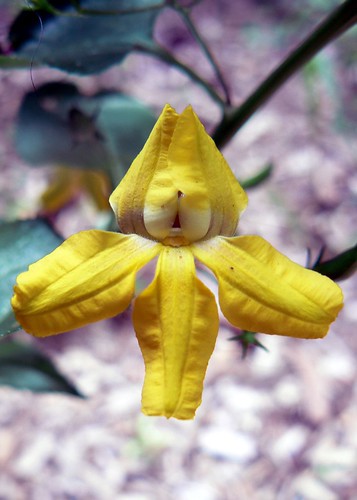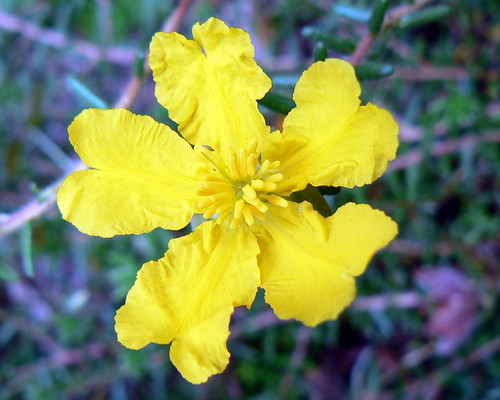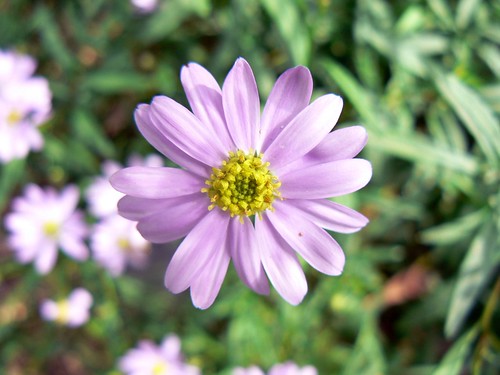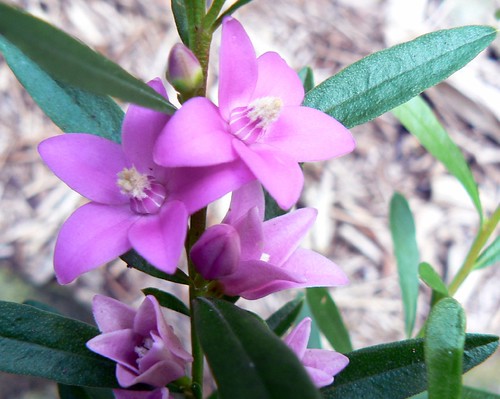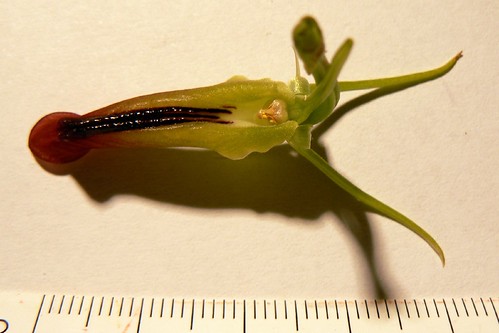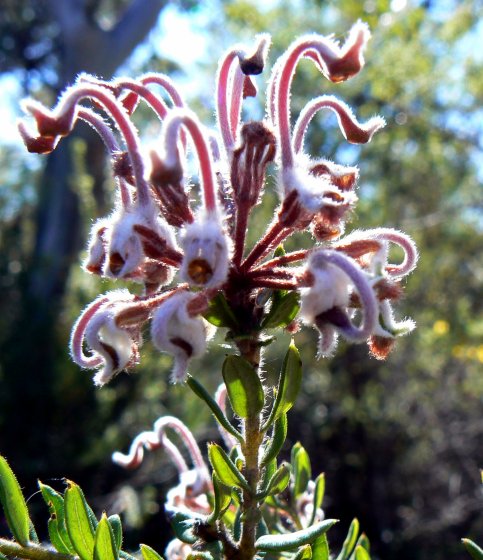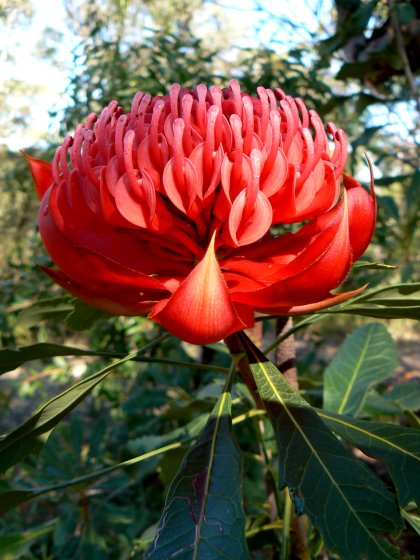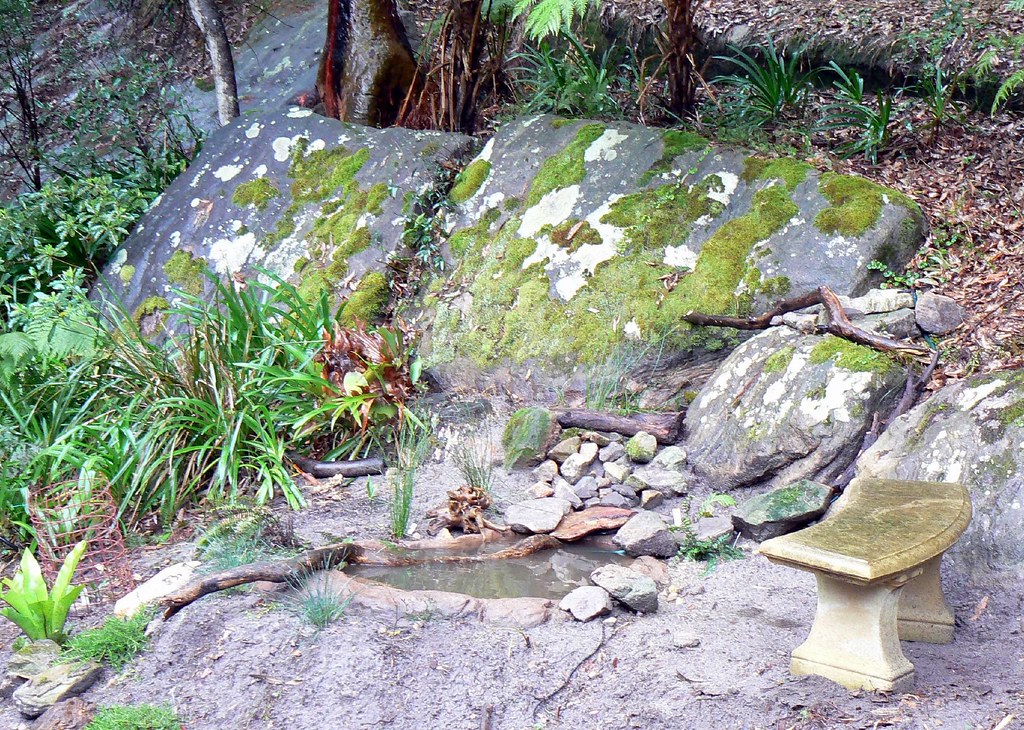The recent rain and summer warmth have coaxed the plants I've cultivated in what were beds full of nasty exotics, into magnificent flower. These are specimens I either grew from cuttings or bought as tubestock. Looks like they're as happy as I am.
So with that, my last post for 2007. Happy new year, everyone! Thanks to those who posted and thanks to all for reading. See you on the other side of the digits. :)
Monday, December 31, 2007
Sunday, December 30, 2007
Food from the Garden.
Today I harvested my potatoes, and got nearly four kilos of Pink Fir Apple and Otway Pink, which isn't bad. The tomatoes, alas, fell victim to possums, so they've ended up in the compost bin. When I build another bed, probably as a no dig patch, I'll try to make it more animal proof.
Instead of more vegies, I've decided to plant this bed out with herbs. I know that the wallabies like eating them, but the fence seems to keep them out. So fingers are crossed!
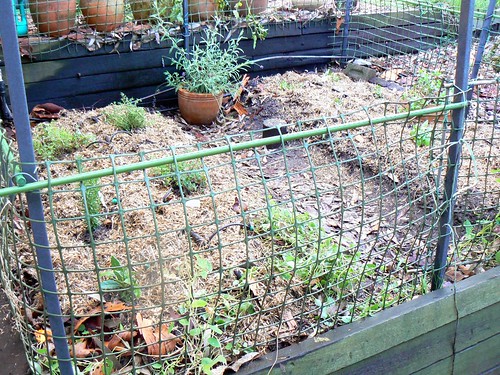
I've planted:
Cooking is something that gives me nearly as much pleasure as gardening, and it'll be great to no longer rely on the green grocer for my herbs. Yum.
Instead of more vegies, I've decided to plant this bed out with herbs. I know that the wallabies like eating them, but the fence seems to keep them out. So fingers are crossed!

I've planted:
- Bay Laurel
- Rosemary
- Basil (three varieties)
- Mint
- Parsley
- Oregano
- Marjoram
- Lemon Grass
- Thyme
- Coriander
- Lavender
- Nasturtium
Cooking is something that gives me nearly as much pleasure as gardening, and it'll be great to no longer rely on the green grocer for my herbs. Yum.
Friday, December 28, 2007
Spring flowers, summer edition.
A few weeks ago, I posted photos of inflorescences of Banksia serrata and Ceratopetalum gummiferum from our garden, with the promise of updated images as they matured.
Here they are:
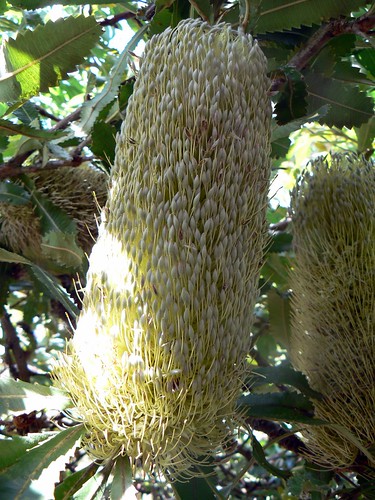 The small flowers within the banksia inflorescences are hugely attractive to local birds, particularly tiny pardalotes and wrens. In a few months, they'll have formed into follicles on the woody axis. They'll eventually open, releasing seed, but that process is much assisted by the heat of bushfire.
The small flowers within the banksia inflorescences are hugely attractive to local birds, particularly tiny pardalotes and wrens. In a few months, they'll have formed into follicles on the woody axis. They'll eventually open, releasing seed, but that process is much assisted by the heat of bushfire.

As you can see from the earlier photo of this plant, the flower has changed from white to red. In fact, the red "petals" are actually the bracts, which remain on the flower well after the petals have gone. The bushland here is dotted these flaming red trees, and are very much a part of a Sydney summer, hence the common name of Ceratopetalum gummiferum, New South Wales Christmas Bush.
Frog update: I've seen some tadpoles in the pond! Don't know what species, but I don't think they're Limnodynastes peronii (which is the frog I heard calling there recently) because its spawn is readily identifiable, floating in a mass on the water surface. I didn't see any spawn at all, which suggests it was submerged. I guess I'll just have to wait till they grow up to find out what they are. Deeply good.
STOP PRESS: The male Brush Turkey (Alectura lathami) who lives near us was just in the back garden, with a mate! I've posted this pic before, but here he is again. Just imagine him now: much the same, but with a big grin on his face. :)
I'll go and visit his mound soon. When she's laid her eggs, she'll bugger off and it'll be his job to tend the mound, maintaining it at the right temperature, till the eggs hatch. Then they're on their own.
Here they are:
 The small flowers within the banksia inflorescences are hugely attractive to local birds, particularly tiny pardalotes and wrens. In a few months, they'll have formed into follicles on the woody axis. They'll eventually open, releasing seed, but that process is much assisted by the heat of bushfire.
The small flowers within the banksia inflorescences are hugely attractive to local birds, particularly tiny pardalotes and wrens. In a few months, they'll have formed into follicles on the woody axis. They'll eventually open, releasing seed, but that process is much assisted by the heat of bushfire.
As you can see from the earlier photo of this plant, the flower has changed from white to red. In fact, the red "petals" are actually the bracts, which remain on the flower well after the petals have gone. The bushland here is dotted these flaming red trees, and are very much a part of a Sydney summer, hence the common name of Ceratopetalum gummiferum, New South Wales Christmas Bush.
Frog update: I've seen some tadpoles in the pond! Don't know what species, but I don't think they're Limnodynastes peronii (which is the frog I heard calling there recently) because its spawn is readily identifiable, floating in a mass on the water surface. I didn't see any spawn at all, which suggests it was submerged. I guess I'll just have to wait till they grow up to find out what they are. Deeply good.
STOP PRESS: The male Brush Turkey (Alectura lathami) who lives near us was just in the back garden, with a mate! I've posted this pic before, but here he is again. Just imagine him now: much the same, but with a big grin on his face. :)
I'll go and visit his mound soon. When she's laid her eggs, she'll bugger off and it'll be his job to tend the mound, maintaining it at the right temperature, till the eggs hatch. Then they're on their own.
Saturday, December 22, 2007
Pearl Beach Field Trip Recce
Yesterday, Louisa and Peta--a couple of my Herbarium colleagues--and I went to Pearl Beach on the NSW Central Coast to check out the place we're staying during the upcoming Plant Science Internship field trip in January. Since I'm going to be cook, I needed to know how well equipped the kitchen is. It's got a big old stove that should happily serve our needs. I just hope my culinary skills do too!
Pearl Beach is a beautiful spot, given to being a holiday house mecca for wealthy celebs, but more interesting for us as an ecologically diverse site for botanising. It's close to coastal heaths, mangrove swamps and temperate rainforest. (Also to leeches, ticks, mosquitoes, sandflies and snakes.... Oh my.)
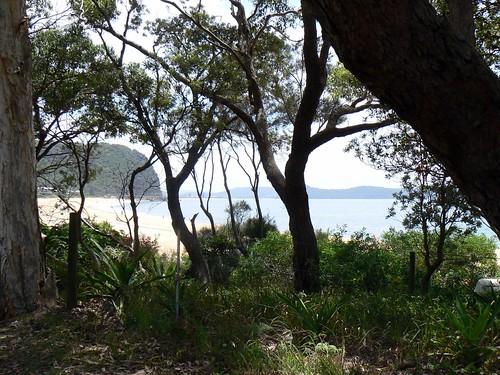
The tree on the left is Melaleuca quinquenervia, Paperbark Teatree, and below, its bark....

This species is typical of the area, growing in coastal swamps and on lake margins on the East Coast of Australia north from Sydney. It's unfortunately become a serious weed in wetlands outside Australia, including in the Florida Everglades, where it grows into huge forests across hundreds of thousands of acres, forming impenetrable monocultures. With the classic irony of the way we screw things up, in some parts of Australia it's becoming quite vulnerable.
Traditionally, Indigenous Australians used the trees for a range of purposes:
And here's a joke, told to me by a plant scientist who is not a molecular biologist:
A molecular biologist was driving through the bush, and came across a farmer herding his sheep along the road. He stopped to let them pass, and got into conversation with the farmer.
"Nice mob of sheep you've got there."
"Yeah. They're good eating."
"Tell you what," said the molecular biologist, "If I can tell you how many sheep you've got, you give me one."
"Okay," said the farmer. "I'm always up for a wager. Go ahead."
"Eighty-six".
"That's pretty good, mate, how'd you work that out?" asked the farmer.
"Oh, in my line of work, you need to be able to quantify things pretty quickly," said the molecular biologist.
"Fair enough," said the farmer. "Help yourself." And the molecular biologist did.
"How about another bet?" said the farmer. "If I guess what your line of work is, you give it back to me."
"All right," said the molecular biologist.
"You're a molecular biologist."
"How'd you know that?" asked the molecular biologist.
"Put down my dog and I'll tell you."
Pearl Beach is a beautiful spot, given to being a holiday house mecca for wealthy celebs, but more interesting for us as an ecologically diverse site for botanising. It's close to coastal heaths, mangrove swamps and temperate rainforest. (Also to leeches, ticks, mosquitoes, sandflies and snakes.... Oh my.)

The tree on the left is Melaleuca quinquenervia, Paperbark Teatree, and below, its bark....

This species is typical of the area, growing in coastal swamps and on lake margins on the East Coast of Australia north from Sydney. It's unfortunately become a serious weed in wetlands outside Australia, including in the Florida Everglades, where it grows into huge forests across hundreds of thousands of acres, forming impenetrable monocultures. With the classic irony of the way we screw things up, in some parts of Australia it's becoming quite vulnerable.
Traditionally, Indigenous Australians used the trees for a range of purposes:
- The bark peels off in strips and has many uses ranging from wrapping food for cooking to making bandages and disposable raincoats. The bark can be used to make containers for food and water storage and for mending holes in canoes.
- A liquid made from the leaves can be used as a wash. The leaves can also be boiled to make a pleasant tea.
- The nectar-rich blossoms can be soaked in water to make a sweet drink.
- All species of melaleuca can be used to treat symptoms of colds, flu and sinusitis by inhaling the steam from boiling or burning the leaves. The young leaves can also be crushed in the hands and released oils inhaled deeply to relive headaches, blocked sinuses, coughs and runny noses. Source: Botanic Gardens, Sydney.
And here's a joke, told to me by a plant scientist who is not a molecular biologist:
A molecular biologist was driving through the bush, and came across a farmer herding his sheep along the road. He stopped to let them pass, and got into conversation with the farmer.
"Nice mob of sheep you've got there."
"Yeah. They're good eating."
"Tell you what," said the molecular biologist, "If I can tell you how many sheep you've got, you give me one."
"Okay," said the farmer. "I'm always up for a wager. Go ahead."
"Eighty-six".
"That's pretty good, mate, how'd you work that out?" asked the farmer.
"Oh, in my line of work, you need to be able to quantify things pretty quickly," said the molecular biologist.
"Fair enough," said the farmer. "Help yourself." And the molecular biologist did.
"How about another bet?" said the farmer. "If I guess what your line of work is, you give it back to me."
"All right," said the molecular biologist.
"You're a molecular biologist."
"How'd you know that?" asked the molecular biologist.
"Put down my dog and I'll tell you."
Wednesday, December 19, 2007
Flannel Flower Gloat Moment
The photo I posted here a while back of the flannel flower (Actinotus helianthi) I'm growing has been chosen for today's Botany Photo of the Day published by UBC Botanical Garden and Centre for Plant Research.
Which is nice.
Just as jolly is that I've sold my first photo. The Herbarium had an art exhibition over recent weeks, "Our Hidden Talents", to which the staff were encouraged to contribute. I entered four photos, and someone liked this one enough to part with ready cash for it. Heck.
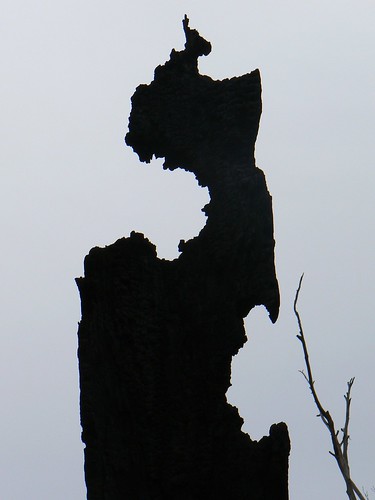
I took this photo, "After the Fire", in February this year, while on the NSW Herbarium Plant Science Internship's field trip to the NSW Central Coast. It's a burnt-out tree in Awaba State Forest.
Which is nice.
Just as jolly is that I've sold my first photo. The Herbarium had an art exhibition over recent weeks, "Our Hidden Talents", to which the staff were encouraged to contribute. I entered four photos, and someone liked this one enough to part with ready cash for it. Heck.

I took this photo, "After the Fire", in February this year, while on the NSW Herbarium Plant Science Internship's field trip to the NSW Central Coast. It's a burnt-out tree in Awaba State Forest.
Saturday, December 01, 2007
Limnodynastes peronii!
Finally, a frog has moved into my pond! It's a Limnodynastes peronii (Striped Marsh Frog) and okay, it's as common as muck, but it's wonderful that finally someone's got the hint.
No photos as yet (I've indeed yet to see him, having only heard his less than dulcet call), but here's a image to go on with (Creative Commons, of course!):
No photos as yet (I've indeed yet to see him, having only heard his less than dulcet call), but here's a image to go on with (Creative Commons, of course!):
Saturday, November 24, 2007
Sandstone Sanctuary
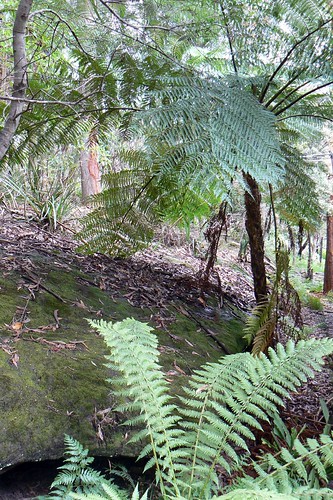 The sandstone rock platform that runs along one side of our property is proving to be a wondrously diverse and relatively undisturbed piece of habitat. As the weather warms up, I'm discovering increasing numbers of plant species, which is such a joy. This is where I found the Cryptostylis subulata I recently blogged about, and there are also Lomandra longifolia, Lomandra filiformis, Lomandra obliqua, Gahnia sp., and a range of monocots I'm yet to identify.
The sandstone rock platform that runs along one side of our property is proving to be a wondrously diverse and relatively undisturbed piece of habitat. As the weather warms up, I'm discovering increasing numbers of plant species, which is such a joy. This is where I found the Cryptostylis subulata I recently blogged about, and there are also Lomandra longifolia, Lomandra filiformis, Lomandra obliqua, Gahnia sp., and a range of monocots I'm yet to identify.Yesterday, looking out the bathroom window, I noticed a Stylidium productum in flower!
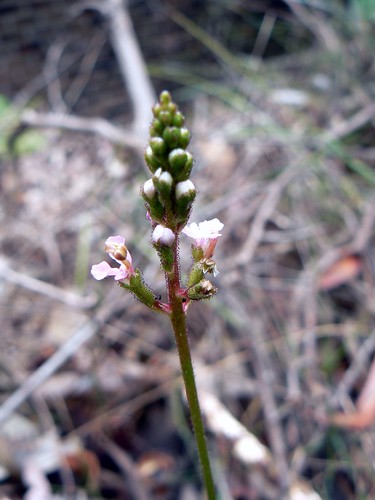
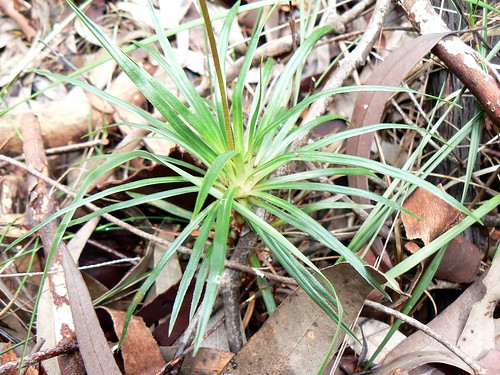
Some while back, when we were still living in Turramurra, I had the same species growing in a pot. It resulted in a far better photo (which was published on Botany Photo of the Day), but having it growing wild is much more satisfying.

An utter favourite of mine is Caustis flexuosa, also known, appropriately enough, as Curly Wigs. I'd love to try propagating it, although I hear it's not an easy task.

(Of course, instead of taking photos and blogging, right now I should be studying for a uni exam on Monday, but to be honest, my brain is in a state of jangling anticipation: today is election day. I've been out to vote and there is nothing to do but wait now to see what the rest of Australia's decided. The tension is excruciating! Please, please, please, let this be the last day of the wretched Howard Government....)
Sunday, November 11, 2007
Spring Photos from the Garden.
Today, after a few days of solid and very appreciated rain, I ventured into the garden, where I took some photos of spring fare.
This is Elaeocarpus reticulatus, also known as Blueberry Ash, Ash Quandong, Blue Olive berry, Fairy Petticoats, Fringe Tree, Koda, Lily of the valley Tree and Scrub Ash. Obviously when it's been observed by white folk, they've been rather taken with it and have coined lots of names. I didn't even realise this was in the garden till I saw the flowers!
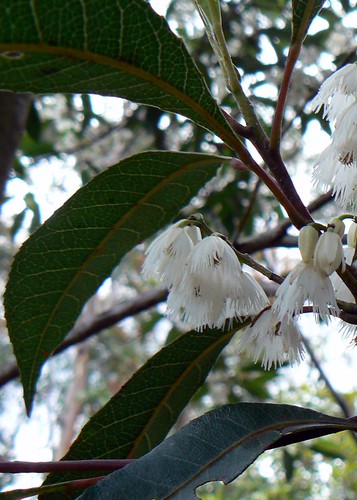
We've a lot of mature Banksia serrata growing. It's astounding how such ancient looking trees, with their knobbly, solid bark, can produce soft new leaves and these extraordinary flower cones each year. This inflorescence is very immature. I'll take another photo when it's older.
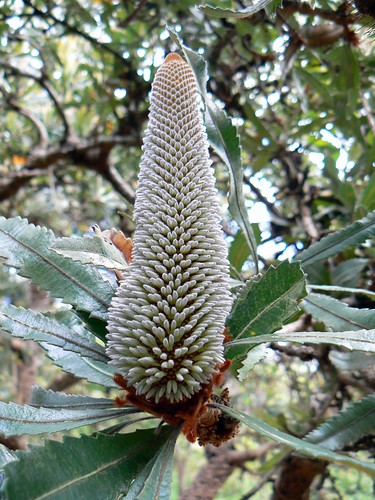
Actinotus helianthi, or Flannel Flower, is local to the area, but this is one I've planted.
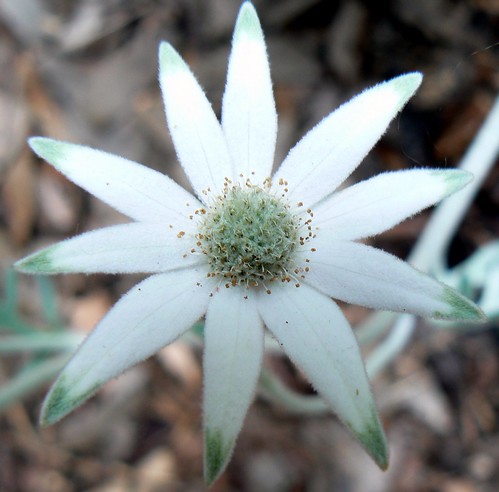
Ceratopetalum gummiferum is the New South Wales Christmas Bush. The flowers are white, but they're followed, at around Christmas time, by persistent red sepals, which bathe the tree in colour. I'll follow this photo up too!

This is Elaeocarpus reticulatus, also known as Blueberry Ash, Ash Quandong, Blue Olive berry, Fairy Petticoats, Fringe Tree, Koda, Lily of the valley Tree and Scrub Ash. Obviously when it's been observed by white folk, they've been rather taken with it and have coined lots of names. I didn't even realise this was in the garden till I saw the flowers!

We've a lot of mature Banksia serrata growing. It's astounding how such ancient looking trees, with their knobbly, solid bark, can produce soft new leaves and these extraordinary flower cones each year. This inflorescence is very immature. I'll take another photo when it's older.

Actinotus helianthi, or Flannel Flower, is local to the area, but this is one I've planted.

Ceratopetalum gummiferum is the New South Wales Christmas Bush. The flowers are white, but they're followed, at around Christmas time, by persistent red sepals, which bathe the tree in colour. I'll follow this photo up too!

Thursday, November 08, 2007
Wednesday, November 07, 2007
Cryptostylis subulata
Native terrestrial orchids are fabulous little creatures, in part because when they're not flowering, they look very insignificant, and then, suddenly, out burst some of the more macabre inflorescences you're likely to encounter.
This is a Cryptostylis subulata (Large Tongue Orchid) growing on the sandstone rock platform next to our house. This afternoon, I looked at it under the microscope. Extraordinary textures, but alas my photography can only begin to convey that.
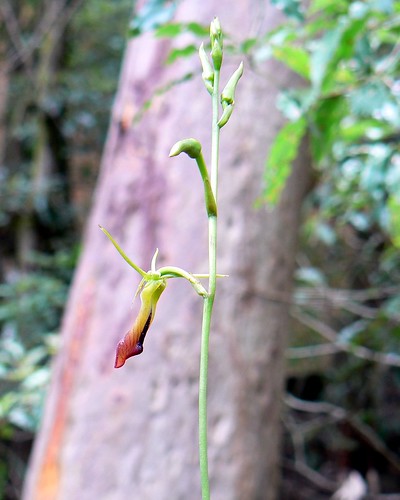
This is a Cryptostylis subulata (Large Tongue Orchid) growing on the sandstone rock platform next to our house. This afternoon, I looked at it under the microscope. Extraordinary textures, but alas my photography can only begin to convey that.

A close up of the underside of the flower.
I'm planning on preserving a specimen to add to the Herbarium's collection. Unfortunately, it won't dry too prettily, but perhaps they'll be able to use one of my photos on PlantNET.
Tuesday, October 30, 2007
2008 Plant Science Internship, National Herbarium of NSW--Applications open!
The next Internship (Jan-Feb 2008) is now calling for applications. Anyone who's read my blog and website accounts of this will know how much I absolutely adored it. I am not exaggerating when I say it changed my life. It certainly led to my current job and to my committing to a B.Sc in Conservation and Biodiversity.
If you or anyone you know can spare 7 weeks in Jan-Feb next year to get advanced work experience and training in botanical science, here it is! (Oh, and that's me, third photo down, pretending to mount a specimen. So to speak.)
I'm going on the Internship's Central Coast field trip. My boss said to me, "We can't take you as a scientist, because you're not one yet, but would you like to be the cook?" So I'll be there, wearing the wacky, zany novelty BBQ apron, and hopefully doing a little botanising on the side.
Seriously, this is the greatest thing for someone with a passion for Australian plants, ecology and biodiversity. Pass it on!
If you or anyone you know can spare 7 weeks in Jan-Feb next year to get advanced work experience and training in botanical science, here it is! (Oh, and that's me, third photo down, pretending to mount a specimen. So to speak.)
I'm going on the Internship's Central Coast field trip. My boss said to me, "We can't take you as a scientist, because you're not one yet, but would you like to be the cook?" So I'll be there, wearing the wacky, zany novelty BBQ apron, and hopefully doing a little botanising on the side.
Seriously, this is the greatest thing for someone with a passion for Australian plants, ecology and biodiversity. Pass it on!
Germination. That was quick.
I sowed my Themeda and Poa seeds just over a week ago, and they've already sprouted! Amazing. I hope the other plants germinate as quickly.
Not interesting enough for a photo though, so instead, here's a pic of a Bassian Thrush, Zoothera lunulata, in our front garden. It has a running gait, freezes after a metre or so, then digs about for insects in the leaf litter. A real sweetie.
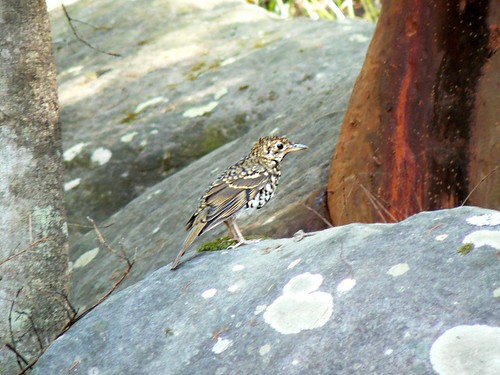
Not interesting enough for a photo though, so instead, here's a pic of a Bassian Thrush, Zoothera lunulata, in our front garden. It has a running gait, freezes after a metre or so, then digs about for insects in the leaf litter. A real sweetie.

Sunday, October 28, 2007
Dragonflies (er, Damselflies...) Do It*.
(*Apologies to Cole Porter.)
(*Edit: And David is quite right. Not dragonflies, but damselflies! See comments section.)
I was pottering about the garden this afternoon and took these photos....
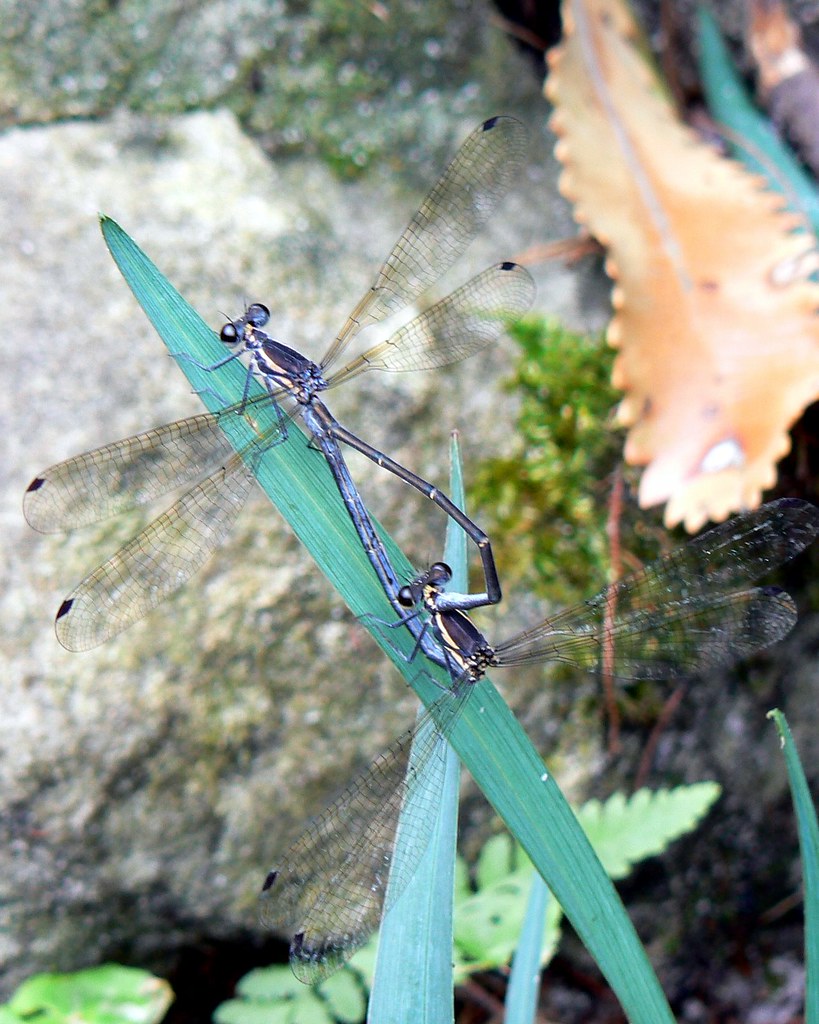
They have been hovering around the pond a lot of late.
These two look to the future. (If only the frogs would take the hint!)
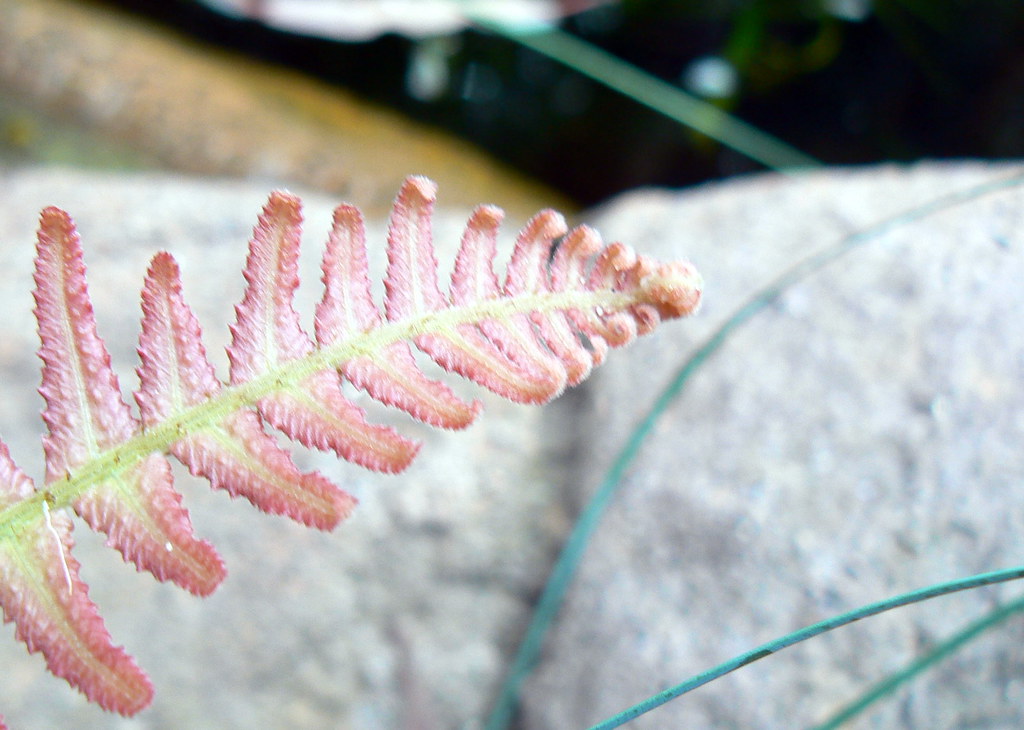 I planted this Doodia aspera next to the pond, and
I planted this Doodia aspera next to the pond, and
it's now unfurling these magnificent new fronds.
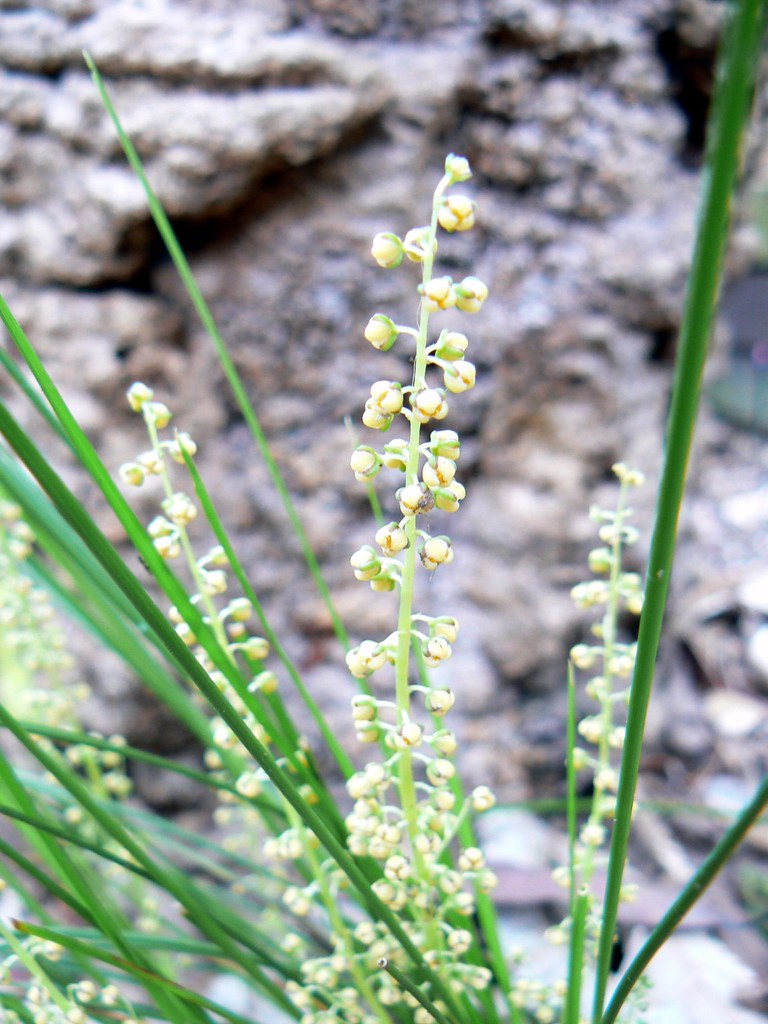 This delicate little monocot I've yet to identify,
This delicate little monocot I've yet to identify,
but now it's flowering, the job will be easier.
Edit: It's Lomandra filiformis, and I've since found a
number of them flowering in the garden. I'll
collect seed for propagation when they're set.
In the background is the trunk of one of the many Banksia serrata
growing in our garden.
(*Edit: And David is quite right. Not dragonflies, but damselflies! See comments section.)
I was pottering about the garden this afternoon and took these photos....

They have been hovering around the pond a lot of late.
These two look to the future. (If only the frogs would take the hint!)
 I planted this Doodia aspera next to the pond, and
I planted this Doodia aspera next to the pond, andit's now unfurling these magnificent new fronds.
 This delicate little monocot I've yet to identify,
This delicate little monocot I've yet to identify,but now it's flowering, the job will be easier.
Edit: It's Lomandra filiformis, and I've since found a
number of them flowering in the garden. I'll
collect seed for propagation when they're set.
In the background is the trunk of one of the many Banksia serrata
growing in our garden.
(P.S. I just realised that a few days ago, my blog had its first birthday. Happy birthday, Blog!)
Saturday, October 27, 2007
Propagation blissage.
Wednesday, October 24, 2007
Potatoes and tomatoes and strawberries....
As spring warms up, naturally a girl's thoughts turn to propagation. My old hot house was covered in clear plastic, but that made it more like a boiling hot house in summer, so I've replaced the plastic with shade cloth, drawing upon ancient sewing lessons from yesteryear. When we've got our water tank, I'll probably set up a sprinkler system on a timer to keep things moist.
At this point, I'm propagating some native grasses to put into some of the bushier areas of the garden (Wallaby Grass, Danthonia sp.; Kangaroo Grass, Themeda triandra; Tussock Grass, Poa labillardieri; and Meadow Grass, Microlaena stipoides, as well as some Hen and Chicken Fern, Asplenium bulbiferum. Before it gets too warm, I'll also do some cuttings, probably of various Grevillea species.

The vegie patch is coming on a treat. Plenty of flowers on the tomatoes, and so far, few pests. With luck I'll be able to stay organic. The drip irrigation system I installed is working well. It's great to be able to use so little water by directing it straight to the plants!
At this point, I'm propagating some native grasses to put into some of the bushier areas of the garden (Wallaby Grass, Danthonia sp.; Kangaroo Grass, Themeda triandra; Tussock Grass, Poa labillardieri; and Meadow Grass, Microlaena stipoides, as well as some Hen and Chicken Fern, Asplenium bulbiferum. Before it gets too warm, I'll also do some cuttings, probably of various Grevillea species.

The vegie patch is coming on a treat. Plenty of flowers on the tomatoes, and so far, few pests. With luck I'll be able to stay organic. The drip irrigation system I installed is working well. It's great to be able to use so little water by directing it straight to the plants!
Sunday, October 14, 2007
Friday, September 28, 2007
Climate Change and the Federal Election
GetUp!, the Australian grassroots lobbying group, has created an ad parodying the Howard Government's climate change policies and spin. In the space of a couple of days, nearly over $200,000 worth of donations have poured in to get this on air during this weekend's Big Boofy Blokes Kicking a Ball Around grand final.
It's so heartening to see so many people digging into their pockets. The environment is finally becoming a mainstream issue!
Here's the ad:
It's so heartening to see so many people digging into their pockets. The environment is finally becoming a mainstream issue!
Here's the ad:
Saturday, September 15, 2007
"Living in a wildlife park..."
This morning, as Maxine (the ten-year old offspring) and I were in the back garden regarding--and being regarded by--a metre-long goanna (Varanus varius), she said to me, "It's like living in a wildlife park." And she's right. How I love living here!

This goanna was a stunner, as interested in us as we were in it. It can't be too old, since they grow to 2 metres, but it looked like it could have done a great deal of damage with those claws. I have a nasty feeling it likes living around here because of the brush turkey eggs and babies. And the frogs. Ah, life's rich tapestry.
And here are some photos that Martien (the spouse) took when he was walking in Berowra Valley this morning. I think I have photographic competition....
Huge day in the garden, today. I've created a new bed, fenced it off from the wallabies, and planted all sorts of goodies. Photos soon!
It's all feeling very spring.

This goanna was a stunner, as interested in us as we were in it. It can't be too old, since they grow to 2 metres, but it looked like it could have done a great deal of damage with those claws. I have a nasty feeling it likes living around here because of the brush turkey eggs and babies. And the frogs. Ah, life's rich tapestry.
And here are some photos that Martien (the spouse) took when he was walking in Berowra Valley this morning. I think I have photographic competition....
Huge day in the garden, today. I've created a new bed, fenced it off from the wallabies, and planted all sorts of goodies. Photos soon!
It's all feeling very spring.
Wednesday, September 12, 2007
Dicksonia antarctica
There are a number of tree ferns in our garden, some of which were already here (mainly Cyathea species), but I've planted one of my favourites, Dicksonia antarctica. It was just a stump when I put it in a couple of weeks ago, but now it's sprouting these beautiful fronds.
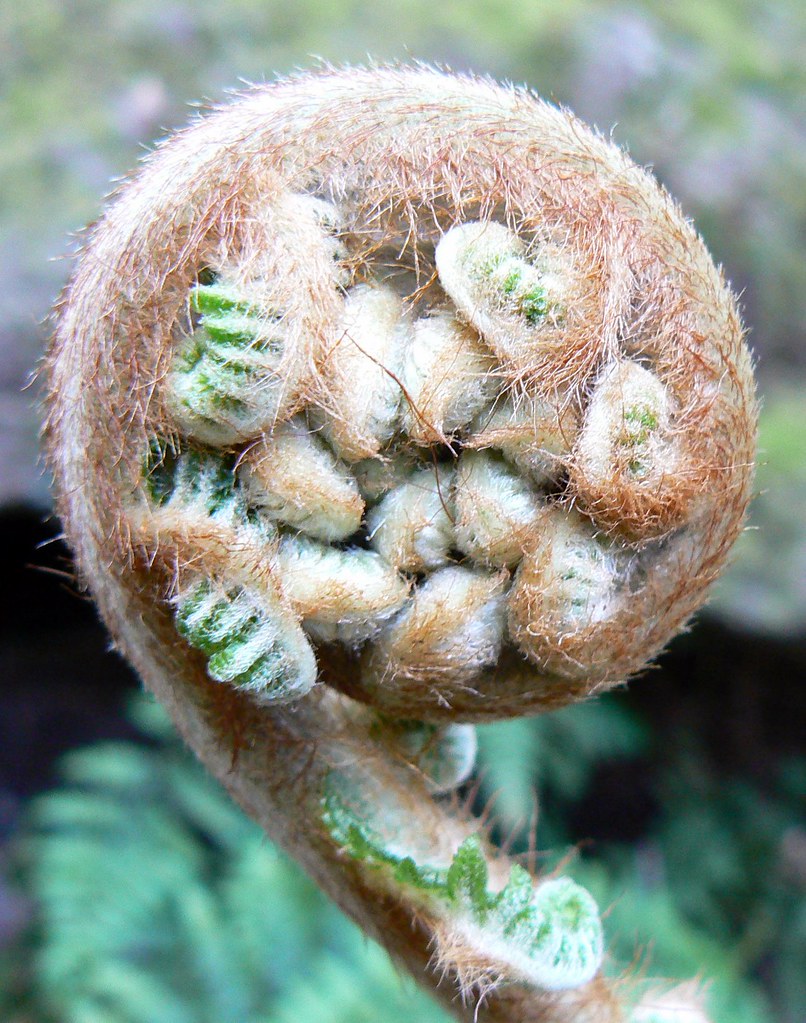
Seriously, they are growing around 2 cm a day. Remarkable energy reserves. Just imagine the frenzied mitosis going on in there!

Seriously, they are growing around 2 cm a day. Remarkable energy reserves. Just imagine the frenzied mitosis going on in there!
Tuesday, September 11, 2007
Fish.
Today, eight Australian rainbow fish (sp. to be advised!) moved in, so now the pond is finally finished.
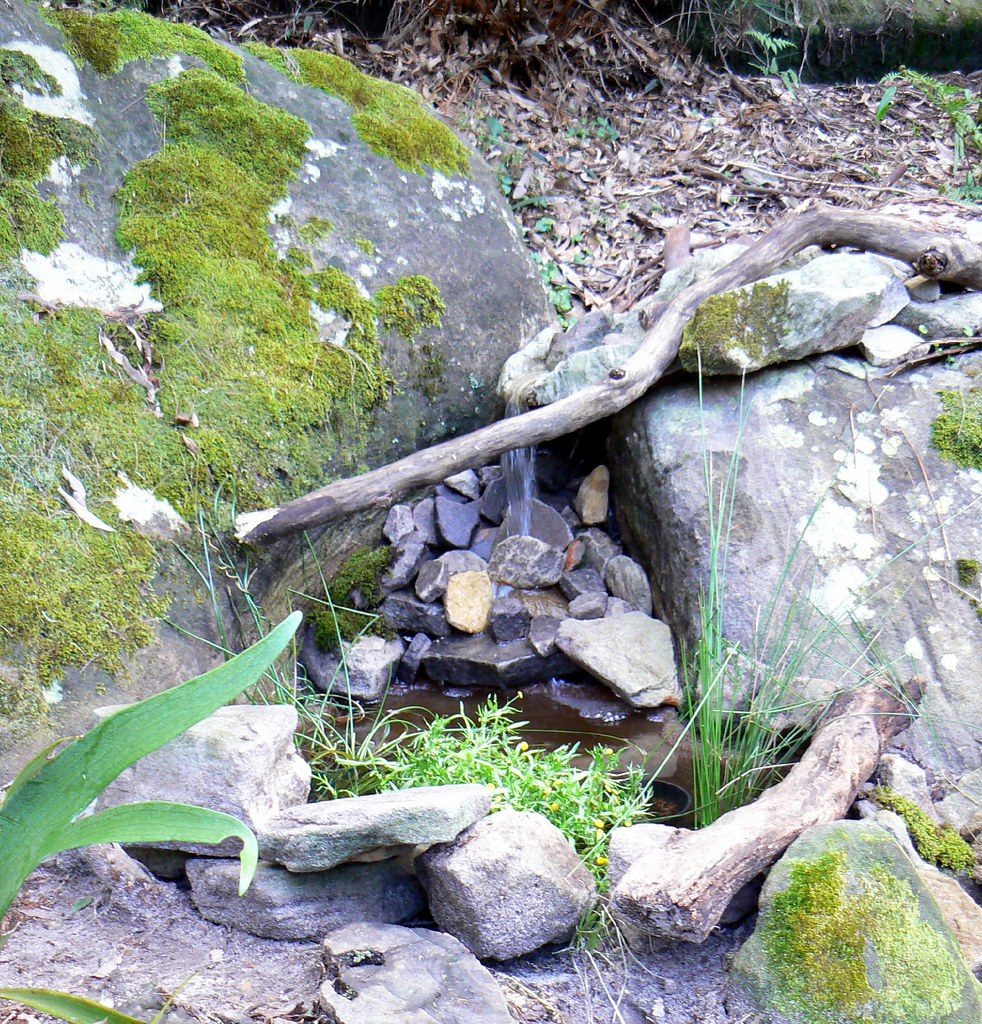
More photos on my website. The photo above is of the small pond. The big pond is to the right....
Below is an Isopogon, growing next to Steve and Jacqui's pond (see previous post.)
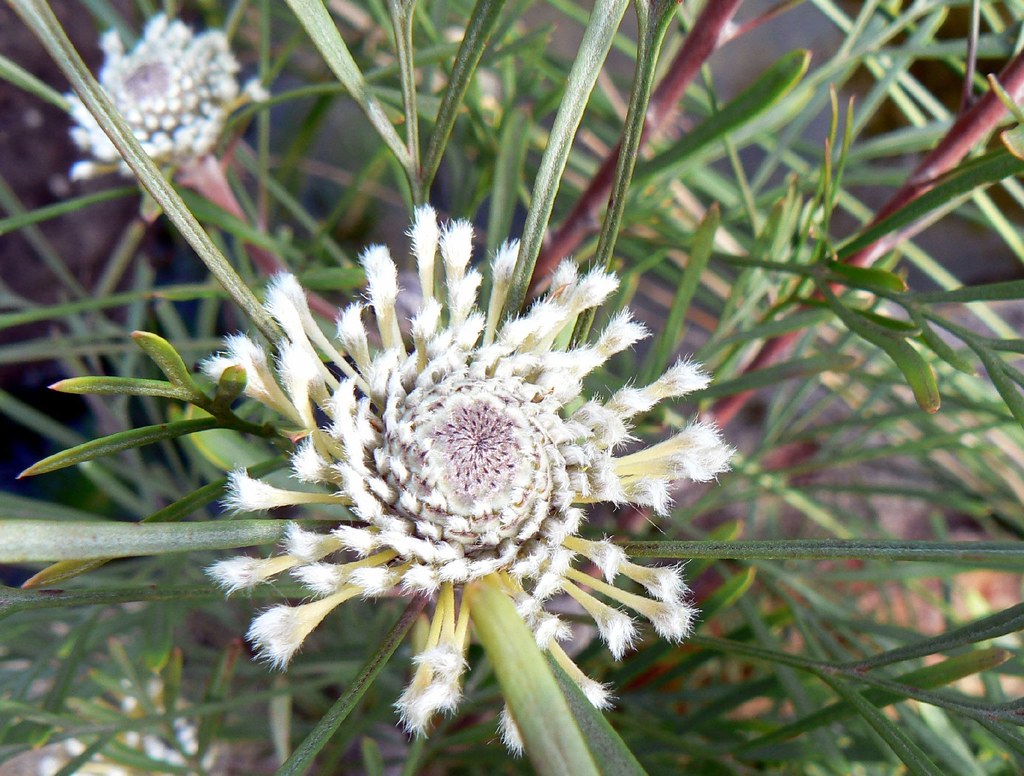

More photos on my website. The photo above is of the small pond. The big pond is to the right....
Below is an Isopogon, growing next to Steve and Jacqui's pond (see previous post.)

Sunday, September 09, 2007
Steve and Jacqui's Pond, a year on.
Just over a year ago, we helped our friends Steve and Jacqui restore and plant out an old pond in their front garden.

Now, it's beautifully established and home to a range of frog species. See the journey from beginning to end, here.
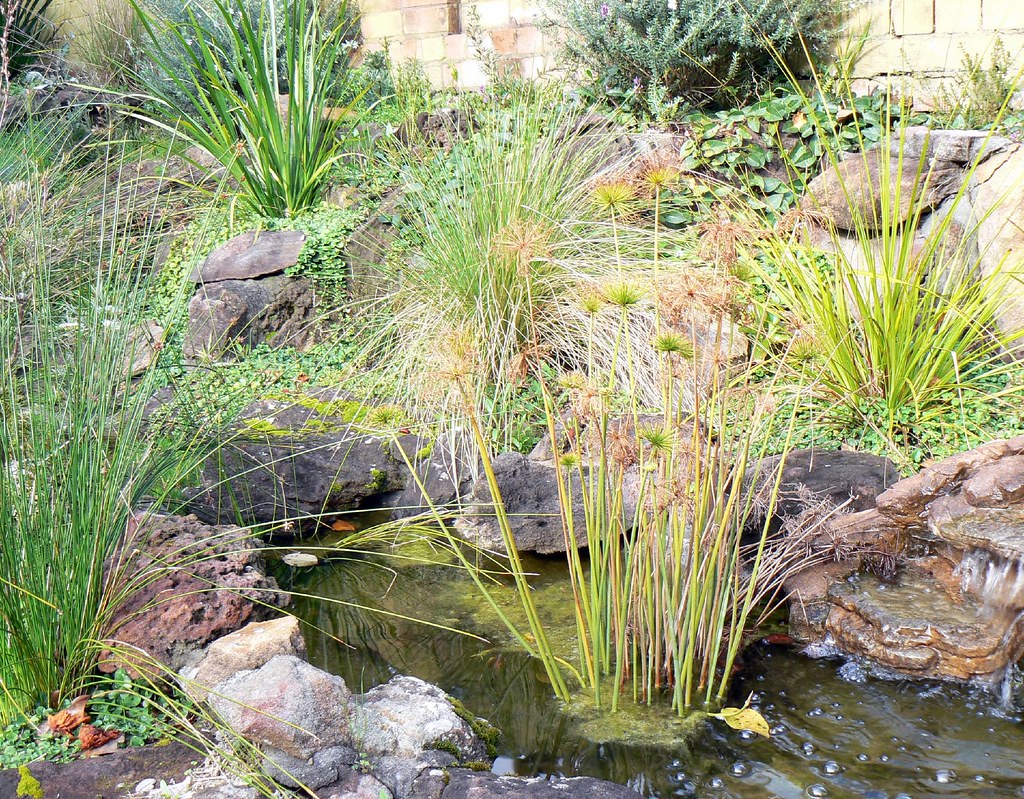
Now, it's beautifully established and home to a range of frog species. See the journey from beginning to end, here.

Wednesday, September 05, 2007
The Brush Turkeys Descend
(As opposed to the Bush turkey. To visit Sydney, do you really need all this? "Two 747s, one of which is the celebrated Air Force One; it is bolstered by several transport planes, one of which will carry two helicopters, not to mention more than a dozen vehicles, including two bulletproof Cadillacs for the purposes of motoring with confidence through Sydney streets while an angry mob of high-school truants chucks eggs and chants 'Hey, hey! Ho, ho! George Bush has got to go!'" It adds up to "total greenhouse emissions of 57,886 tonnes of carbon dioxide equivalents, or to put it another way, the amount produced by 2000 average Australians over the course of a whole year," according to Annabel Crabb in the Sydney Morning Herald. But that's not what this post is about.)
A while ago, I mentioned that Brush Turkeys (Alectura lathami) breed in our area. Well, it looks like they're getting ready to do just that. We've had a few sightings in the last few days, including this, just outside the sunroom window:


It's a little hard from these photos to get a sense of just how big this bird is. But it's around the size of a medium-sized dog. It's around 70 cm long. So we're not talking a mere chook here.
Having just planted my spring/summer crops (tomatoes, potatoes and strawberries), I am hoping my fences are sufficient to keep this gorgeous creature in the right part of the garden....
A while ago, I mentioned that Brush Turkeys (Alectura lathami) breed in our area. Well, it looks like they're getting ready to do just that. We've had a few sightings in the last few days, including this, just outside the sunroom window:


It's a little hard from these photos to get a sense of just how big this bird is. But it's around the size of a medium-sized dog. It's around 70 cm long. So we're not talking a mere chook here.
Having just planted my spring/summer crops (tomatoes, potatoes and strawberries), I am hoping my fences are sufficient to keep this gorgeous creature in the right part of the garden....
Tuesday, August 28, 2007
Total Lunar Eclipse
Well, not the best photo I've ever taken, but it was a stunning eclipse, all the "blood red moon" that we were promised. I think I like taking photos of little things more.

We went up to the park near our house to watch the eclipse tonight. There were a number of people there, which was heartening. I always love it when I realise that being boggled by nature is a passion shared by many. Perhaps people came from other parts of Sydney, since our suburb is on the outskirts and surrounded by bush, rather than city lights.
When we returned home, our neighbours, who manufacture and sell optical telescopes, were out on their driveway with a nicely huge telescope, so we got to see it really close up.

We went up to the park near our house to watch the eclipse tonight. There were a number of people there, which was heartening. I always love it when I realise that being boggled by nature is a passion shared by many. Perhaps people came from other parts of Sydney, since our suburb is on the outskirts and surrounded by bush, rather than city lights.
When we returned home, our neighbours, who manufacture and sell optical telescopes, were out on their driveway with a nicely huge telescope, so we got to see it really close up.
Sunday, August 19, 2007
The soothing sound of burbling

Now, more landscaping and planting. And waiting for the frogs!
Check out the latest pond page on my website.
Check out the latest pond page on my website.
Saturday, August 11, 2007
I don't get it.
I don't get it, #1.
Why do so many TV celebrity gardeners say "folage" instead of "foliage"? I can understand someone who hasn't studied plants saying it, but these people are horticulturists! I must have missed the hort class, Bizarre Pronunciations 101.
I don't get it, #2.
Why do so many bloggers write "teh" instead of "the"? It's not a typo, obviously. It's far too prevalent and pointed.
Not much garden news, I'm afraid. I'm just getting over the 'flu. Every time I try to work in the garden, I'm exhausted within minutes and have to have a good lie down. Bah.
Why do so many TV celebrity gardeners say "folage" instead of "foliage"? I can understand someone who hasn't studied plants saying it, but these people are horticulturists! I must have missed the hort class, Bizarre Pronunciations 101.
I don't get it, #2.
Why do so many bloggers write "teh" instead of "the"? It's not a typo, obviously. It's far too prevalent and pointed.
Not much garden news, I'm afraid. I'm just getting over the 'flu. Every time I try to work in the garden, I'm exhausted within minutes and have to have a good lie down. Bah.
Saturday, July 28, 2007
Small things.
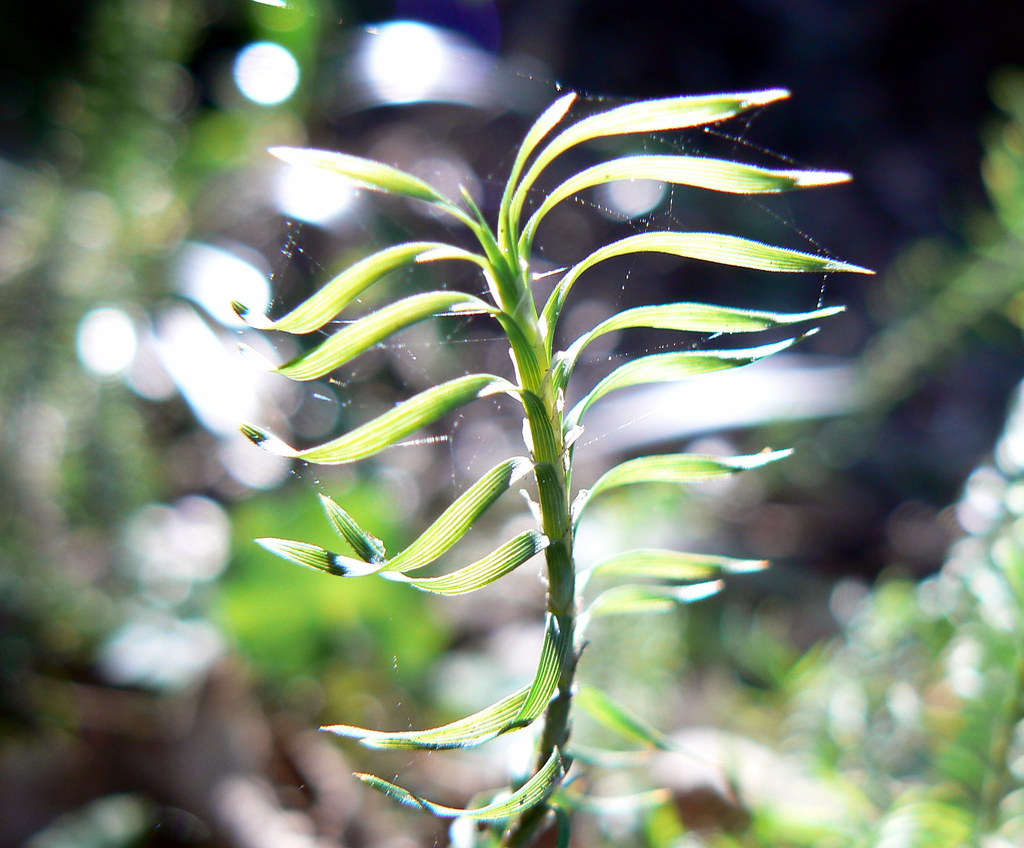
I've been pottering about the garden, taking advantage of my camera's lovely macro facility. I know I keep banging on about Lomandra obliqua, but it just captivates me. Click on these images to see larger versions--they look much better big.
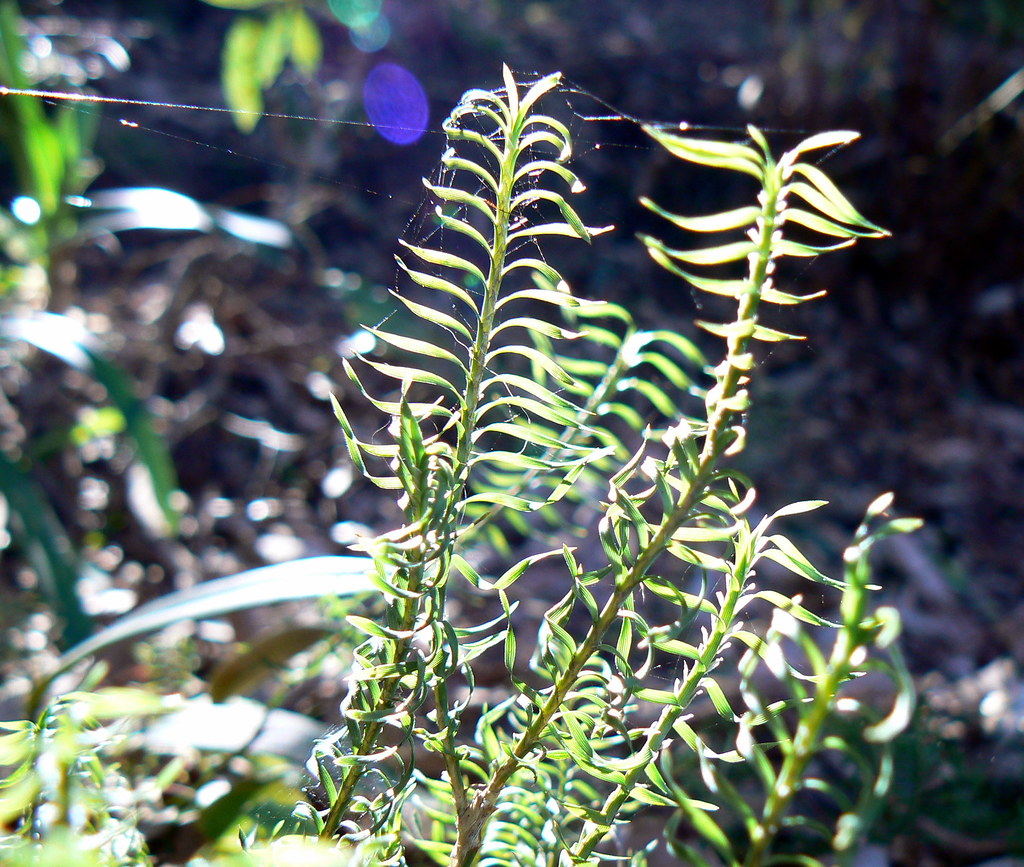
And what better way to celebrate my new job with the bryophytes than to take a photo of moss?

This moss is growing on the rocks above the pond. And speaking of the pond, take a look at what we got up to today! (If you've a burning desire to learn how to glue PVC sheeting to fibreglass--and let's be honest, who doesn't?--it's very much in your interests to read it.)
There are more photos of small things on my website.
Ringtail Possum Drey
I took Bob's advice, and constructed further accommodation for the local ringtails....
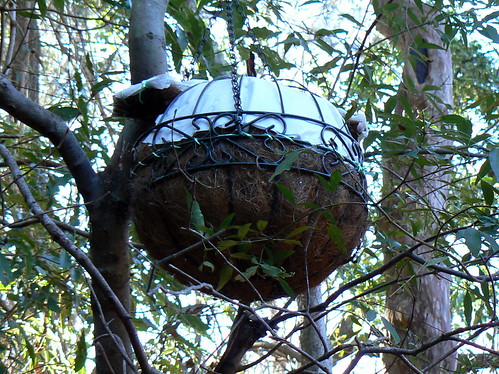
Thanks, Bob!
I'll let you know as soon as someone moves in.

Thanks, Bob!
I'll let you know as soon as someone moves in.
Subscribe to:
Posts (Atom)
